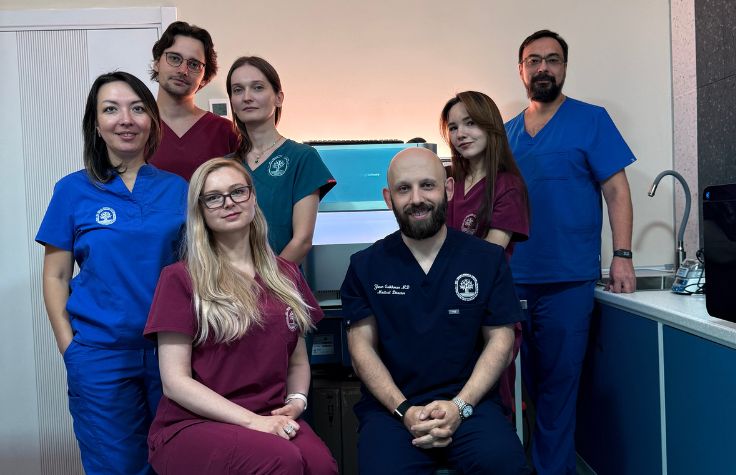
18 November 2025
The world is fighting a battle on the tiniest scale—antimicrobial resistance (AMR). Antimicrobials are medications used to treat infectious diseases, and AMR occurs when pathogens stop responding to them. When bacteria, viruses, fungi, and parasites become resistant to drugs, they are much more difficult to treat, are more likely to cause severe disease or death, and spread more easily. AMR is a product of evolution: As we develop drugs to treat infectious diseases, it puts selective pressure on the pathogens—and overprescription and overuse of antimicrobials accelerates the process. It’s survival of the fittest, and, as much progress as we have made in antimicrobial development, we will eventually lose if we can’t keep up.
AMR is on the rise, and studies suggest that it’s one of the leading causes of death worldwide. In 2021 alone, bacterial AMR caused 1.14 million deaths and contributed to an additional 4.71 million deaths. To address AMR, in 2015 the World Health Organization (WHO) established the Global Antimicrobial Resistance and Use Surveillance System to standardize AMR data collection, reporting, and sharing, and to develop strategic priorities, such as improving AMR surveillance and increasing access to quality diagnosis and treatment of drug-resistant infections.
Each year from November 18 to November 24, WHO also commemorates World AMR Awareness Week, a global educational campaign to raise awareness of the dangers of AMR, increase the value of shared data, and encourage health, environment, and government systems to take bold, united action to address these priorities.
Everyone from research and pharmaceutical organizations to public health professionals plays a role in this effort, and Illumina is helping by harnessing the power of the genome. Advancements in next-generation sequencing (NGS) technology have transformed the field of microbial genomics, enabling researchers to gain deep insights into the biological mechanisms of AMR. These insights inform surveillance and control procedures for public health professionals, identify therapeutic targets for pharma companies, and provide information on treatment options for clinicians.
Finding the path of least antimicrobial resistance
To gain a leg up in the battle against AMR, scientists need to precisely understand the mechanism driving it—genomic adaptation. Like any life form, a pathogen’s fundamental goal is to stay alive long enough to replicate. As a result, infection control becomes a race against evolution. To maintain an advantage, scientists must continually identify genomic and phenotypic indicators of emerging antimicrobial resistance. At the core of this strategy are microbial genome sequencing, which quickly identifies genomic changes in pathogens, and genomic epidemiology, which tracks and controls AMR based on that information.
One example of how genomics can support public health intervention against the dangers of AMR is methicillin-resistant Staphylococcus aureus (MRSA), a type of staph infection that’s highly resistant to several antibiotics. While typical staph infections are common and usually not a concern for healthy people, if a person becomes infected with MRSA, their treatment options are limited. Due to the overprescription of antibiotics, MRSA has now shifted from being mainly confined to hospitals to posing a serious threat in everyday community settings. For example, athletes who have skin-to-skin contact with others are now at higher risk. If an athlete is injured and becomes infected with MRSA, the prescribed antibiotic may fail, worsening the infection as well as helping the bacteria spread. And when someone infected with MRSA enters a health care setting, such as a hospital, where patients are more vulnerable to infection, it increases the risk of transmission considerably—jeopardizing lives. Genomic sequencing enables epidemiologists to identify the origin of an MRSA outbreak and take action.
“NGS is a powerful technology that helps address the global AMR crisis across the care continuum,” says Courtney Maus, director of global medical affairs, infectious diseases, at Illumina. “For example, targeted NGS is recommended by WHO for the detection of drug-resistant Mycobacterium tuberculosis to help address AMR at an individual level. NGS is also used in surveillance efforts to stop and prevent the spread of antimicrobial-resistant organisms, particularly in health care settings where patients are vulnerable to infections.”
Armed with Illumina whole-genome sequencing (WGS) technology, NGS, and library prep kits, scientists can better inform AMR reduction strategies. WGS and NGS tools detect and characterize pathogens and AMR genes and markers, enabling health care systems to predict phenotype resistance, monitor patterns of resistance, and rapidly detect it. Microbial genomic data also helps researchers gain insight into the efficacy of antimicrobial drugs, informing the development of new medications to help improve patient care.

Following the microbial genomics road
Organizations worldwide are already using WGS and NGS to understand how pathogens are changing over time. Research organizations, universities, and laboratories have formed partnerships to improve AMR surveillance infrastructure (across middle- and low-income countries), generate actionable open data, and support public health programs, and these programs are developing effective interventions to respond to emerging AMR.
Here’s how five Illumina customers are using genomics to address AMR in their community.
The Microbial Genomics Group at the University of Zurich’s Institute for Medical Microbiology is using NGS to better understand the biological mechanisms that lead to AMR, which will aid scientists in developing new diagnostic tests and treatments.
MicroGenDX in Lubbock, Texas, is using NGS microbial profiling to quickly identify and develop targeted treatments for specific pathogens—providing a lifesaving window of opportunity for patients with postoperative infections, sepsis, acute infections, respiratory infections, and more.
The Next-Generation Sequencing Core at the Public Health Laboratory in Washington, DC, is using NGS to develop a respiratory syncytial virus (RSV) surveillance system to understand how different strains are spreading in real time and provide guidance on prevention and outreach efforts.
Advanta Genetics in Tyler, Texas, is tackling AMR through precision metagenomics—using NGS to sequence the genetic and microbial profile, including AMR markers, of the infection.
The Centre for Tuberculosis at the National Institute for Communicable Diseases in Johannesburg is using NGS to track drug-resistant tuberculosis in South Africa, enabling scientists to detect it earlier and reduce the risk of transmission.


